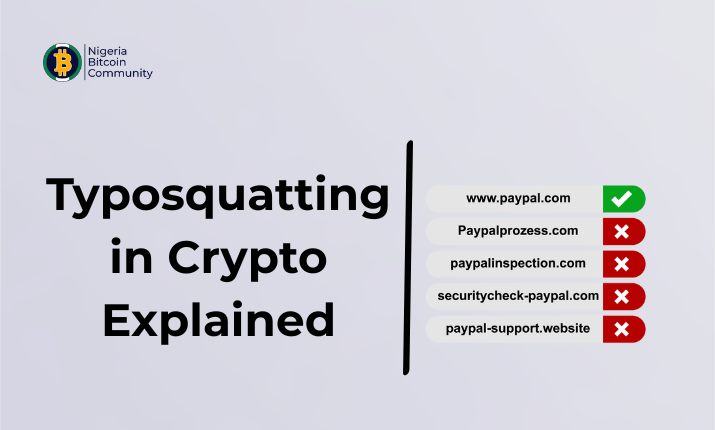In today’s post, we will discuss typosquatting – a new crypto scam.
Crypto hacks and scams are rife nowadays, especially in the crypto space.
With each passing day, these hackers come up with new ways of scamming people out of their coins.
Typosquatting is one of those ways, and I will explain all there is to know about it in subsequent subheadings.
Let’s dive in.
What is Typosquatting in Crypto?

Typosquatting in crypto is when scammers create fake websites that look like real crypto platforms but with minor spelling mistakes in their web addresses.
For example, someone trying to visit ‘www.coinbase.com’ might accidentally type ‘www.coinbsae.com’ or ‘www.conbase.com’ and land on a scam website.
Or, while you are in a rush to type ‘www.binance.com’, you might end up typing ‘www.binace.com’ or ‘www.binanace.com’ or ‘www.biance.com’, which will bring you to a fake page.
Scammers register website names that look almost like popular crypto platforms, hoping that people will make small typing mistakes when entering a website address.
These fake websites trick people into sharing sensitive information, like passwords or private keys, which can lead to loss of money and security risks.
Once this happens, hackers can take control of a user’s digital assets.
Since blockchain transactions are difficult to reverse, once funds are stolen, they are usually gone forever.
Who is Affected by Typosquatting?
- Crypto Developers – Fake sites damage the reputation of real projects and sometimes steal money meant for them.
- Crypto Users – People who fall for typosquatting scams lose money, personal information, or infect their devices with malware.
A well-known case involved scammers running fake exchanges called NanoBit and CoinW6, stealing $3.2 million from investors by gaining their trust on social media.
In 2019, six people were arrested in the UK and the Netherlands after they stole 24 million euros by creating fake crypto exchange websites.
Over 4,000 people in 12 countries were affected.
I listed how scammers carry out this typosquatting scam below.
How Typosquatting Works in Crypto
Scammers use different tricks to carry out typosquatting, including:
i. Registering Fake Domains
Scammers purchase website addresses that look almost like real crypto sites, changing just one or two letters.
For example: “bitcoiin.com” instead of “bitcoin.com.”
ii. Phishing Attacks
Fake sites trick people into entering their login details, which are then stolen.
Some sites also spread malware.
iii. Fake Crypto Wallets and Tokens
Scammers create wallet addresses or tokens that look like real ones.
If a user sends crypto to a fake wallet, the funds are lost forever.
iv. Mimicking Legit Websites
These fake websites copy the design and layout of real crypto platforms, making them hard to spot.
Researchers found that typosquatters actively use these tactics, with millions of dollars lost due to small typing mistakes.
How to Protect Yourself from Typosquatting
- Check Website URLs Carefully – Always double-check the website address before logging in.
- Bookmark Important Websites – Save the correct website in your browser to avoid typing errors.
- Use Security Features – Always enable two-factor authentication (2FA) on your accounts.
- Register Similar Domains – Crypto companies should buy common misspellings of their website names to prevent fraud.
- Report Suspicious Sites – If you find a fake crypto website, report it to the company and domain registrars.
How to Report Typosquatting Scams
If you come across a typosquatting scam, take these steps:
- Report the Fake Website – Contact the domain registrar where the site is registered.
- Seek Legal Help – If the scam caused significant financial loss, a lawyer can help.
- Notify Crypto Exchanges – If funds were sent to a fake wallet, inform the exchange or platform.
- Use Blockchain Explorers – Record the details of fraudulent transactions using blockchain tracking tools.
Each country has different organizations to report cybercrimes:
- United States – Report to the Internet Crime Complaint Center (IC3) and U.S. Patent and Trademark Office.
- United Kingdom – Contact Action Fraud and the UK Intellectual Property Office.
- Australia – Report scams to the Australian Cyber Security Centre (ACSC) and ReportCyber.
Conclusion
Typosquatting remains a major risk in the crypto world.
However, by staying informed and taking security measures, we can reduce our chances of falling victim to these scams.
To be sure you are signing up with the right exchange, check these out:
Till my next post, keep hodling… WAGMI!



0 Comments